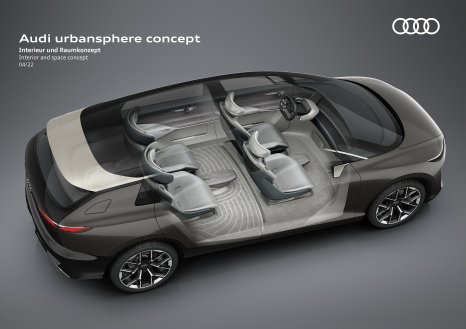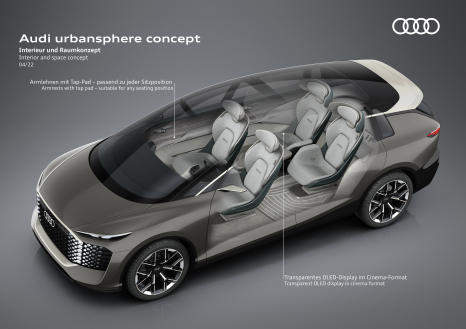Audi urbansphere concept – Interior and space concept
Surface, form, function – the interior
The doors of the Audi urbansphere concept are counter-hinged at the front and the rear; there is no B-pillar. As a result, the whole world of urbansphere interior opens up to passengers as soon as they climb in. Seats that swivel outward and a red carpet of light projected onto the ground next to the vehicle transform the very act of entering the car into an experience of comfort.
A wheelbase of 3.40 meters (11.2 feet) and a vehicle width of 2.01 meters (6.6 feet) delineate what is a more than stately footprint, even for a luxury-class automobile. Together with 1.78 meters (5.8 feet) of headroom and expansive glass surfaces, these dimensions provide an exceptionally spacious experience of the interior.
Four individual seats in two rows offer passengers luxurious first-class comfort. The seats in the rear offer particularly generous dimensions and a wide range of adjustment options. In Relax and Entertain modes, the backrest can be tilted up to 60 degrees while leg rests extend at the same time. The center-mounted armrests integrated into the sides of the seats and their counterparts in the doors create a comforting feeling of security.
The seats also cater to passengers’ changing social needs in a variety of ways. While conversing, they can turn to face each other on their swiveling seats. On the other hand, those who want some seclusion can conceal their head area from the person sitting next to them using a privacy screen mounted behind the headrest. In addition, each seat has its own sound zone with speakers in the headrest area. Individual monitors are also built into the backs of the front seats.
When passengers want to use the infotainment system together, on the other hand, there is a large-format and transparent OLED screen that pivots vertically from the roof area into the zone between the rows of seats.
Using this “cinema screen,” which occupies the entire width of the interior, the two passengers in the back row can take part in a video conference together or watch a movie. Even split-screen use is possible. When the screen is not in use, it offers a clear view into the front thanks to its transparent design or – when folded upwards – through the glass roof area to the sky. 4/8
Like in the Audi grandsphere concept, the interior of the urbansphere blends space and architecture, digital technology, and authentic materials into a single entity. The lines emphasize the vehicle’s horizontal proportions. The open, wide interior supports the impression of a one-of-a-kind space. The steering wheel, pedals, and conventional dashboard can be hidden during automated driving, which enhances the feeling of transparency and spaciousness.
The seating surfaces and backs of the two seats with integrated seat belts are visually separate. Between the rear seats – normally locked in place in a low position – is a center console that swivels upwards. It contains a water dispenser and glasses – another testament to the Audi urbansphere concept’s first-class credentials.
The Audi urbansphere also qualifies as a wellness zone thanks to innovative digital options that emerged in no small part through input from the co-creation process with Chinese customers. Stress detection is a prime example – this adaptive program uses facial scans and voice analysis to determine how passengers are feeling and offers personalized suggestions for relaxation, for example with a meditation app that can be used via the personal screen and the private sound zone in the headrests.
Less is more – displays and operation
In the Audi urbansphere, simplicity has become a design principle. Neither circular instruments nor black screens for virtual display concepts are visible before activating the driving functions.
Instead, passengers find clearly structured and calm zones made from the highest quality materials. Wood and wool, as well as synthetic textile fabrics, are used in paneling, seat coverings, and floor carpets, all of which have a high-quality feel and are pleasant to the touch.
Soft beige and gray tones structure the interior horizontally. A dark, toned-down green serves as the color of the seat shells and soothes the eye. The interior color zones become lighter from top to bottom and, together with the natural light entering the space, create a homogeneous, wide interior.
The vehicle comes to life at the touch of a fingertip, along with a number of displays, albeit in the form of projections on the wooden surfaces below the windshield, which can be surprising at first. Depending on the driving status – whether manual with a steering wheel or level 4 – they are either distributed across the entire width of the interior or segmented for the driver and front-seat passenger, displaying all of the necessary travel information in ultra-high resolution throughout the journey.
In addition, a sensor bar is integrated under the projection surfaces for quick switching between content – for instance, for music or navigation. It shows all the functions and applications that are active in the car. Icons flash for the different menus. 5/8
One particular, extremely innovative control element is located near the door cut-out on the interior cladding: the MMI touchless response. If the passenger is sitting in the upright position, far forward in his or her respective area, they can use this element to physically select various function menus via a rotating ring and buttons and click their way through the individual levels, allowing for simple and intuitive operation.
Even if the seat is fully reclined, passengers can still make use of this convenient feature thanks to a combination of eye-tracking and gesture control. A sensor directed at the eye detects the line of sight when the control unit is to be engaged. And the passenger only needs to make hand movements that are similar to physical operation – without leaning over – to operate the system without touching a thing.
Whether it is eye-tracking, gesture or voice control, or touch, the same thing applies to all operation modes: the Audi urbansphere concept adjusts to the individual user and learns his or her preferences and frequently used functions – and on that basis, it can not only sensibly complete rudimentary commands but also give personalized suggestions directly to the user.
Control panels are even integrated into the armrests on the doors. That way, the car always offers passengers invisible touch surfaces using an optic indicator to show its position. At the same time, there are VR glasses in the armrests on the left and right doors that can be used in conjunction with infotainment options – for instance for the Holoride system.
Sustainability as a guiding principle
Many of the materials in the interior of the Audi urbansphere concept, such as the hornbeam veneers, come from sustainable sources. This choice of material makes it possible to use wood that has grown close to the site, and the entire trunk can be utilized. No chemicals are used during the manufacturing process.
The seat padding is made of ECONYL®, a recycled polyamide. This material can also be recycled after its use in the automobile – without any loss of quality. The fact that the respective materials are installed separately also plays an important role in the ability to recycle them, as mixing them would drastically reduce the potential for recycling.
Bamboo viscose fabric is used in the armrests and in the rear of the vehicle. Bamboo grows faster than ordinary wood, sequesters a great deal of carbon, and doesn’t require herbicides or pesticides to grow.

